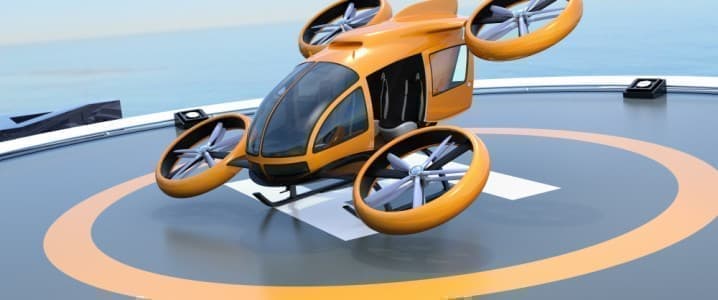Advanced air mobility (AAM) may no longer be a pipedream, as several cities around the globe are conducting pilot projects in the hope of launching commercial operations over the next decade. Innovations in AAM could lead to the launch of air taxi services in several spots worldwide, helping commuters to avoid traffic and get to their destinations faster.
Electric vertical take-off and landing (eVTOL) vehicles rely on electric propulsion, powered by electric motors that allow them to take off and land vertically, reducing the urban space needed to transport people. Unlike other aircraft that require a runway, eVTOLs are ideal for busy, urban environments. They are typically powered by batteries rather than internal combustion engines, meaning they do not burn fossil fuels. Some of the benefits of using eVTOL compared to other aircraft include reduced emissions, lower noise pollution, and higher efficiency.
Several companies have emerged in the eVTOL space in recent years, such as Joby Aviation and Volocopter. Companies investing in the space vary from established aerospace firms to innovative start-ups. As the lithium-ion batteries we use in electric vehicles (EVs) continue to improve in range, cost, weight, and efficiency, those same batteries can be used for eVTOL, which is generating more optimism in the AAM space.
The air taxi market is expected to grow from $43 billion in 2025 to $86.6 billion by 2034, according to a Research and Markets report. This anticipated improvement is owing to rapid technological and regulatory advancements and the growing demand for this type of transport. Advanced technologies, such as artificial intelligence (AI), are expected to drive innovation and boost efficiency in the coming years.
Laurie Garrow, the co-director of Georgia Tech’s Centre for Urban and Regional Air Mobility, said that the rollout of eVTOLs will require greater investments in associated infrastructure, such as the Vertiports needed for aircraft to take off and land vertically. In addition, “charging systems and robust fire safety protocols for high-energy batteries” will be key, said Garrow. “And perhaps most critically, we need ‘rules of the road in the sky’ to manage air traffic around existing airports.”
Several countries worldwide are developing eVTOL operations to launch commercial air taxi services over the next decade. In South Korea, in October, Korean Air signed a deal with U.S.-based Archer Aviation to launch commercial electric air taxis, with a view to purchasing up to 100 aircraft.
Archer announced that the agreement means that its Midnight eVTOL will be used “across multiple applications and use cases, starting with government applications.” The aircraft is designed to carry out between a 10- and 20-minute flight, and a prototype recently completed a series of performance test flights, with two of its highest-altitude flights to date. The U.S. firm has gained the backing of some industry majors, including Boeing and Stellantis. It is currently producing six aircraft at two facilities in the U.S. In September, Archer won a bid to acquire rival Lilium’s portfolio of around 300 AAM patent assets for $21 million, thereby expanding its portfolio to over 1,000 patent assets.
The United Arab Emirates has big plans of its own. The Chinese EV maker Xpeng recently showcased its eVTOL in the Gulf state – the Land Aircraft Carrier, a two-seater EV that can be flown with or without a pilot. Ali Ahmad Al Blooshi, an aviation expert at Dubai Civil Aviation, stated, “We imagine the airspace as being like a street today.” Meanwhile, Michael Du, Xpeng Aeroht’s CFO and vice president, said, “During our R&D process, we have made 200 of those and conducted more than 5,000 safety testing flights in extreme heat, high altitude, extreme cold, moist areas.”
And it’s not just air taxis that the AAM sector is looking to develop. In a recent white paper published by the World Economic Forum (WEF) in collaboration with Kearney, they authors discuss the potential for multiple applications of AAM. “Advanced air mobility is spearheading innovative new technology in the aviation industry… Application opportunities for AAM are manifold across passenger and non-passenger (goods and services) transport clusters,” the report states.
It outlines how innovations in AAM are expected to reshape how we think about air travel, logistics and urban transport, as the aircraft could be used for passenger transport and goods delivery, as well as in emergency response and to access remote locations.
However, to achieve the commercial rollout of AAM, some hurdles must first be overcome. Governments hoping to launch eVTOL must establish clear regulatory frameworks and support public awareness campaigns to encourage social acceptance. In addition, greater investment must be seen in associated infrastructure, such as Vertiports and charging stations.
There is significant potential for the commercial rollout of eVTOL within the next decade, based on successful test flights and rapid innovations in technology. However, to achieve commercial flight, aviation companies must work with governments to develop informed regulatory frameworks, establish flight routes, and develop the infrastructure needed to support operations.
By Felicity Bradstock for Oilprice.com
More Top Reads From Oilprice.com
Oilprice Intelligence brings you the signals before they become front-page news. This is the same expert analysis read by veteran traders and political advisors. Get it free, twice a week, and you’ll always know why the market is moving before everyone else.
You get the geopolitical intelligence, the hidden inventory data, and the market whispers that move billions – and we’ll send you $389 in premium energy intelligence, on us, just for subscribing. Join 400,000+ readers today. Get access immediately by clicking here.



Leave a Comment
Your email address will not be published. Required fields are marked *